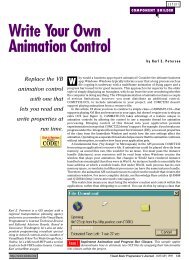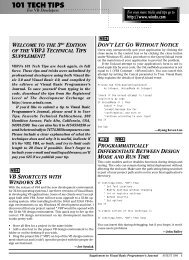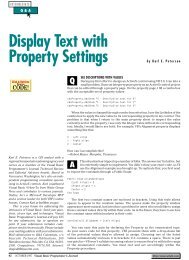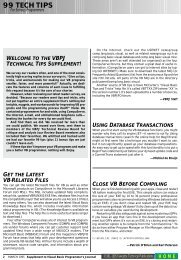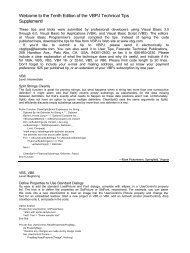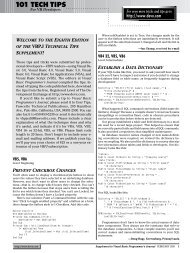101 Tech Tips - Visual Studio Magazine - One-Stop Source Shop
101 Tech Tips - Visual Studio Magazine - One-Stop Source Shop
101 Tech Tips - Visual Studio Magazine - One-Stop Source Shop
- No tags were found...
You also want an ePaper? Increase the reach of your titles
YUMPU automatically turns print PDFs into web optimized ePapers that Google loves.
<strong>101</strong> TECH TIPSFor <strong>Visual</strong> <strong>Studio</strong> DevelopersXML, .NET beta 1 and upLevel: Beginning✰✰✰✰✰ Five Star TipVS.NETLevel: BeginningRead XML Documents EfficientlyIn applications where you need to read XML documents in the mostefficient manner possible, consider using the XmlTextReader classrather than the XmlDocument class. The XmlTextReader is a streamthat allows tokens found in the source XML document to be read ina forward-only manner without loading the entire XML documentinto memory as with the DOM. Although at first glance this mightseem similar to Simple API for XML (SAX), the XmlTextReaderexposes a pull model rather than the push model found in SAX. Thepull model offers many performance benefits. Using theXmlTextReader in an ASPX page is as simple as calling the read()method (you must reference the System.Xml namespace):XmlTextReader reader = newXmlTextReader(Server.MapPath("myfile.xml"));while (reader.Read()) {if (reader.NodeType == XmlNodeType.Element) {Response.Write("Found an Element!");if (reader.HasAttributes()) {while (reader.MoveToNextAttribute()) {Response.Write(" Found an Attribute!");}}}}// Make sure you close the stream to prevent file lockingreader.Close();VB5, VB6, SQL Server 7.0 and upLevel: Intermediate—Dan Wahlin, Chandler, Ariz.Execute a Temporary SQL Stored ProcedureIf a user doesn’t have permission to create a stored procedure inSQL Server (version 7.0 or later), he or she can still use ADO tocreate a temporary stored procedure and execute it from VB:Dim cmd As ADODB.CommandDim conn As ADODB.ConnectionSet conn = New ADODB.ConnectionSet cmd = New ADODB.Command' Replace the connection string values below as' required.conn.Open "Provider=SQLOLEDB;Data" & _" <strong>Source</strong>=MyData<strong>Source</strong>;Initial" & _" Catalog=InitialCatalog; User" & _" ID=userID;Password=password"strCmd = "SELECT Customers.CustomerID, OrderID," & _" ContactName INTO #tempTable FROM Customers" & _" INNER Join Orders ON Orders.CustomerID =" & _" Customers.CustomerID"cmd.ActiveConnection = conncmd.CommandText = strCmdcmd.CommandType = adCmdTextcmd.Prepared = Truecmd.ExecuteUsing the Prepared property causes SQL Server to create andstore a temporary stored procedure in the tempdb database, in atechnique known as Prepared/Execute. The command text cancontain most things you could put in a SQL stored procedure.—Parthasarathy Mandayam, Bellevue, Wash.Use #region and #endregion to Organize CodeThe #region and #endregion preprocessor directives define blocksof code you can expand or collapse in the <strong>Visual</strong> <strong>Studio</strong> editor:#region MenuHandlersprivate void OnNew (object sender, EventArgs e){Invalidate ();}private void OnExit (object sender, EventArgs e){Close ();}private void OnOpen (object sender, EventArgs e){Close ();}private void OnSave (object sender, EventArgs e){Close ();}#endregionThis code defines a region called MenuHandlers. You can expandor collapse this node in <strong>Visual</strong> <strong>Studio</strong> using the <strong>Visual</strong> <strong>Studio</strong> EditorOutline feature. This feature lets you show only the code you’reworking with; it hides the rest in a class.VB4, VB5, VB6Level: Intermediate—Bill Wagner, Manchester, Mich.Déjà QueueI especially enjoyed the “Quick and Easy Queue” tip in the 11thedition of “<strong>101</strong> <strong>Tech</strong> <strong>Tips</strong> for VB Developers” [<strong>Visual</strong> BasicProgrammer’s Journal March 2001]. You can use the technique for an“undo” menu/toolbar option. Use a collection instead of a listbox toreduce overhead. Support for both LIFO and FIFO is also included:Public Queue As New CollectionPublic Const Q_LIFO = 0Public Const Q_FIFO = 1Public Sub Enqueue(QueueItem As Variant)Queue.Add QueueItemEnd SubPublic Function Dequeue(Optional Mode As Long) As VariantDim Position as LongIf Queue.Count > 0 ThenIf Mode = Q_LIFO ThenPosition = Queue.CountElsePosition = 1End IfDequeue = Queue(Position)Queue.Remove PositionElseDequeue = NullEnd IfEnd Function—Brian Ray, Rockford, Ill.10 Supplement to <strong>Visual</strong> <strong>Studio</strong> <strong>Magazine</strong> SEPTEMBER 2001



